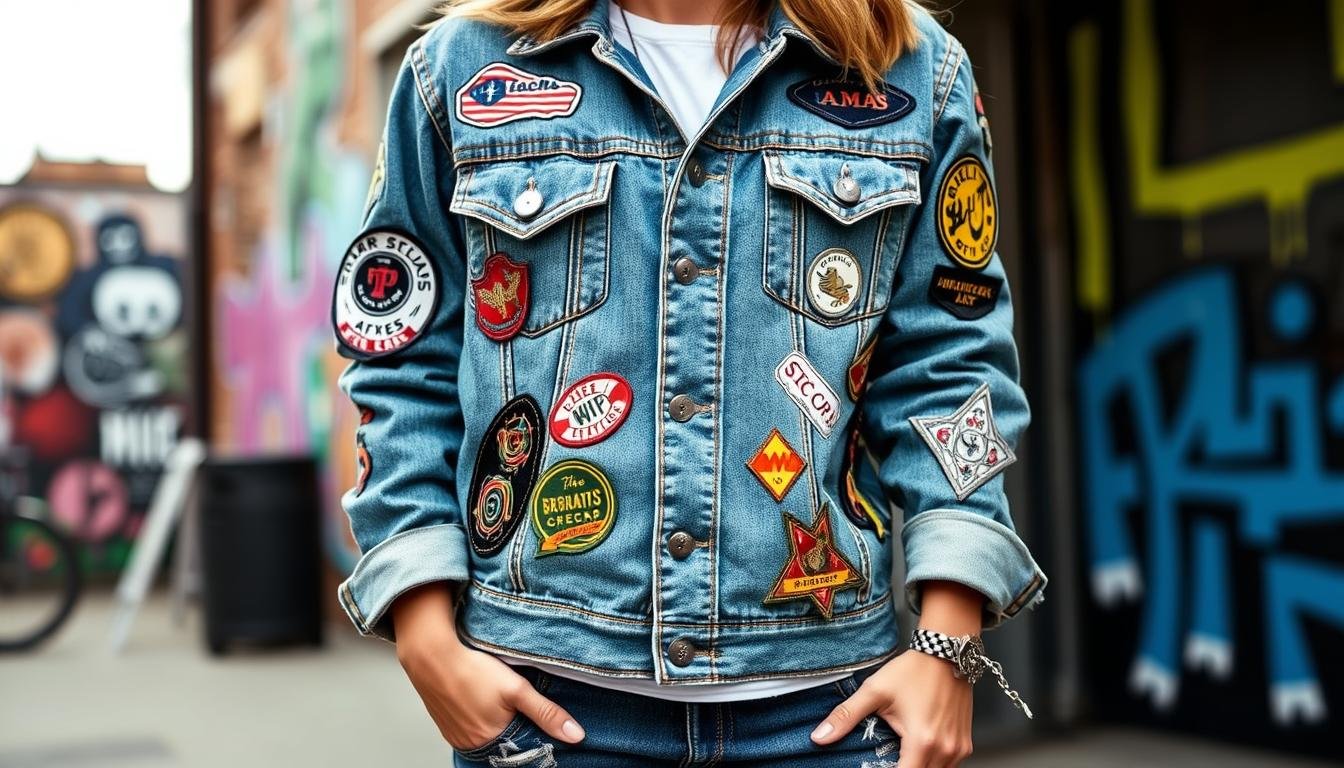This is a close-up of a hand applying an embroidered patch onto a denim jacket using a hot iron. It shows a steaming iron and the shiny surface of the patch, with colorful threads and fabric textures in vivid detail. The background is slightly blurred to emphasize the patch application process.
Iron-on patches are a fun way to show your style. You can use them to cover tears or add flair to your clothes.
Many people love using patches to make their clothes unique. Iron-on patches are also easy to use, and you don’t need to be good at sewing to use them.
This guide will teach you how to apply patches like a pro. You’ll learn how to make your patches last through many washes.
Let’s start making your clothes truly special with iron-on patches!
Introduction to Ironing on Patches
Patches are a fun way to make clothes and bags unique. Iron-on patches let you easily show your style.
These patches use heat to stick to the fabric. They come in many fabulous designs.
The glue on patches melts when hot. This makes them stick to the fabric.
Some fabrics work better for patches. Cotton, denim, and polyester blends are great choices.
Silk and thin fabrics need extra care. Always check if the fabric can handle heat first.
Iron-on patches are easy to use. You don’t need to know how to sew.
Anyone can customize their stuff with these patches. They’re great for jackets, backpacks, and gifts.
Choosing the Right Patch for Your Project
Knowing different iron-on patch types is key for DIY projects. Embroidered patches work great on denim jackets and backpacks.
Printed patches offer bright colours for smooth fabrics like cotton and polyester. Fabric choice matters for patch success.
Cotton, denim, and polyester blends work well with iron-on patches. Silk or thin fabrics may need special care.
Patch size is essential. Small patches are great for sleeves or pockets.
Large patches make bold statements on jackets or shirts. Pick a patch that fits your style and garment.
Texture and material are crucial. Glitter patches add sparkle to festive looks.
Embroidered patches look more professional. Some patches have heat-activated adhesive for strong bonding.
Always check the patch’s fabric type. Follow the maker’s instructions for the best results.
Preparing Your Materials for Ironing
Ironing patches need careful prep and the right tools. Gather a clean iron, sturdy board, pressing cloth, and patch.
Check the heat settings of your iron for your fabric type. Patch placement is key for a pro look.
Lay out your fabric and smooth wrinkles—Mark where you want the patch with a ruler.
Wash and dry the fabric first. This stops shrinking after ironing.
Iron the patch area to make it flat. Use a pressing cloth to protect the fabric and patch.
Try the method on scrap fabric first. This helps you find the proper heat and pressure.
Good prep and tools make patches look great. They’ll stay put, too!
The Ironing Process Made Simple
Applying iron-on patches needs care and skill. Choose the proper heat for your fabric and patch.
Protect your work area with a clean ironing board. Place a thin cloth between the iron and the patch.
Set your iron to medium-high for most patches. Press firmly for 30-45 seconds with even pressure.
Don’t slide the iron, as it may move the patch. Press both sides of the fabric for a strong bond.
Let the patch cool, then check if it’s secure. Some patches may need a second pressing.
Follow the instructions that come with your patch. With practice, you’ll get great results every time.
Caring for Your Ironed Patches
Keep your custom designs fresh with proper patch maintenance. Follow these tips to protect your ironed-on patches.
Turn garments inside out before washing. Use cold water and a gentle cycle.
Choose mild, color-safe detergents. Avoid harsh cleaners that can damage the patch adhesive.
Air dry or use low heat for patch longevity. Remove items while damp if using a dryer.
Check patches often for wear or loose edges. Reapply lifting patches with a low-heat iron and cloth.
These simple care steps will keep patches vibrant. Your creative customizations will last for years to come.
Creative Ways to Style Your Patches
A stylish denim jacket adorned with various colourful patches arranged in creative placements, showcasing trendy designs, alongside a pair of distressed jeans featuring matching patches. The background is a casual urban setting with an artsy vibe, emphasizing a laid-back fashion aesthetic.
Patches have changed personal style. They offer unique ideas to make ordinary clothes stand out.
Denim jackets, backpacks, and jean pockets are great for patches. These items let you show who you are.
Patches are now powerful style statements. Vintage band patches look cool on leather jackets.
Motivational text patches work well on messenger bags. Quirky graphic patches can make caps more fun.
Streetwear fans love mixing different patch styles. This creates unexpected visual stories on clothes.
Clever patch placement can make old clothes new again. Try grouping small patches on jacket sleeves.
You can create a cool gradient effect with patches. Large statement patches look great on denim jacket backs.
Customizing hats, shoes, and tote bags is fun. These items let you show off your creativity.
Patches aren’t just for clothes. They can spruce up your home, too.
Try adding patches to throw pillows or lampshades. This turns ordinary items into personal art pieces.
Conclusion and Final Tips
Iron-on patches open up a world of personalized style options. With each patch, you’ll boost your DIY skills and create unique fashion statements.
Patience and practice are crucial for professional-looking results. Take care when selecting patches and preparing materials.
Don’t hesitate to try different placements and styles. Each patch adds character to your wardrobe.
Iron-on-patch success is about creativity and enjoyment. Start simple and work up to complex designs.
Your confidence will grow with each successful application, and you’ll soon create personal style statements that showcase your spirit.
Iron-on patches offer an affordable way to refresh your look. Transform ordinary items into extraordinary personal art pieces.
FAQ
What materials do I need to iron on patches?
You’ll need an iron, ironing board, pressing cloth, patch, and garment. Make sure your iron has adjustable heat settings.
Use a clean, flat surface to work on.
How do I know if a patch is iron-on?
Iron-on patches have a shiny, adhesive backing that becomes tacky when heated. Most are labelled as “iron-on” or have heat-activated adhesive.
If unsure, check the packaging or contact the manufacturer.
What fabrics work best for iron-on patches?
Cotton, denim, polyester, and canvas work best for iron-on patches. Avoid delicate fabrics like silk or leather.
Check the fabric care label before applying a patch.
What temperature should I use when ironing on a patch?
Use medium to high heat (350-400°F) without steam. The ideal temperature depends on the fabric and patch type.
Place a thin cloth between the iron and the patch.
How long should I press the iron on the patch?
Apply firm pressure for 30-45 seconds. Move the iron slowly over the entire patch.
Thicker patches may need longer pressing for complete adhesion.
Can I wash clothes with iron-on patches?
Yes, but wait 24-48 hours after applying. Use cold water and turn the garment inside out.
Air drying is best to keep the patch stuck.
What if my patch doesn’t stick completely?
Reheat the patch with firm, even pressure. If it still won’t stick, use fabric glue.
Consider sewing the edges for extra security.
Can I remove an iron-on patch?
Removing an iron-on patch is challenging and may damage the fabric. Use a seam ripper to detach it carefully.
Clean any leftover glue with fabric adhesive remover.
Are iron-on patches permanent?
Iron-on patches can come loose with washing and wear. For best results, add stitches around the edges.
Can I iron on patches to bags or shoes?
Fabric bags and canvas shoes work well. Avoid leather or suede.
Always test a small, hidden area first.
you may also read : Nike Tech Jacket: Ultimate Style and Performance Guide



